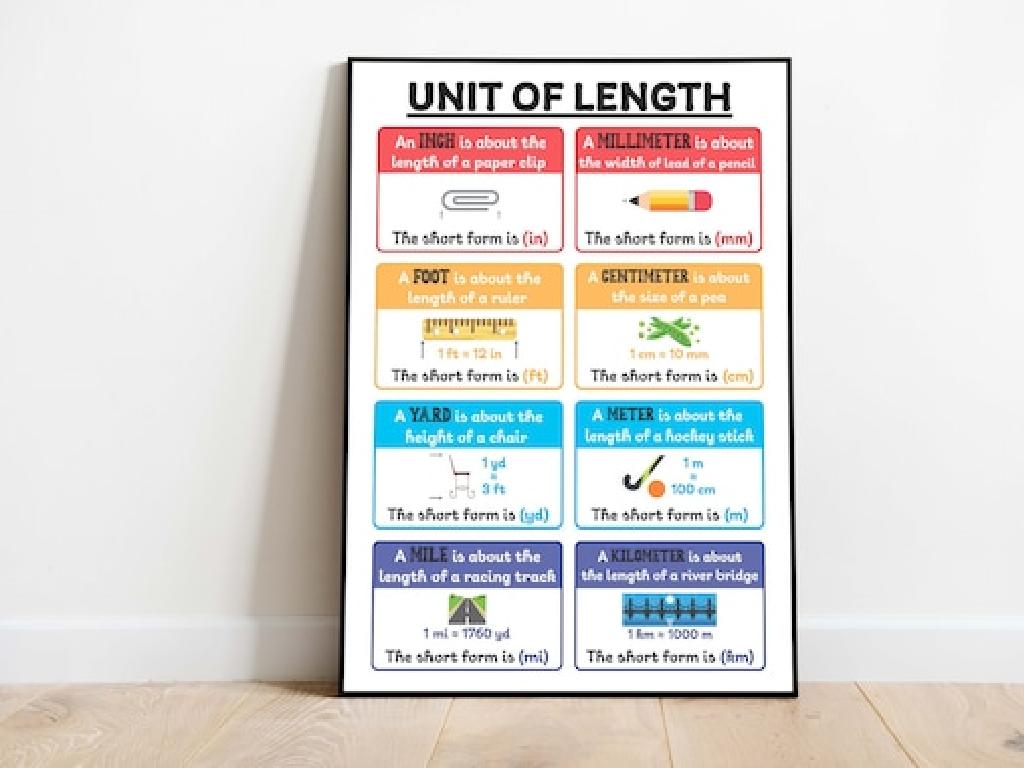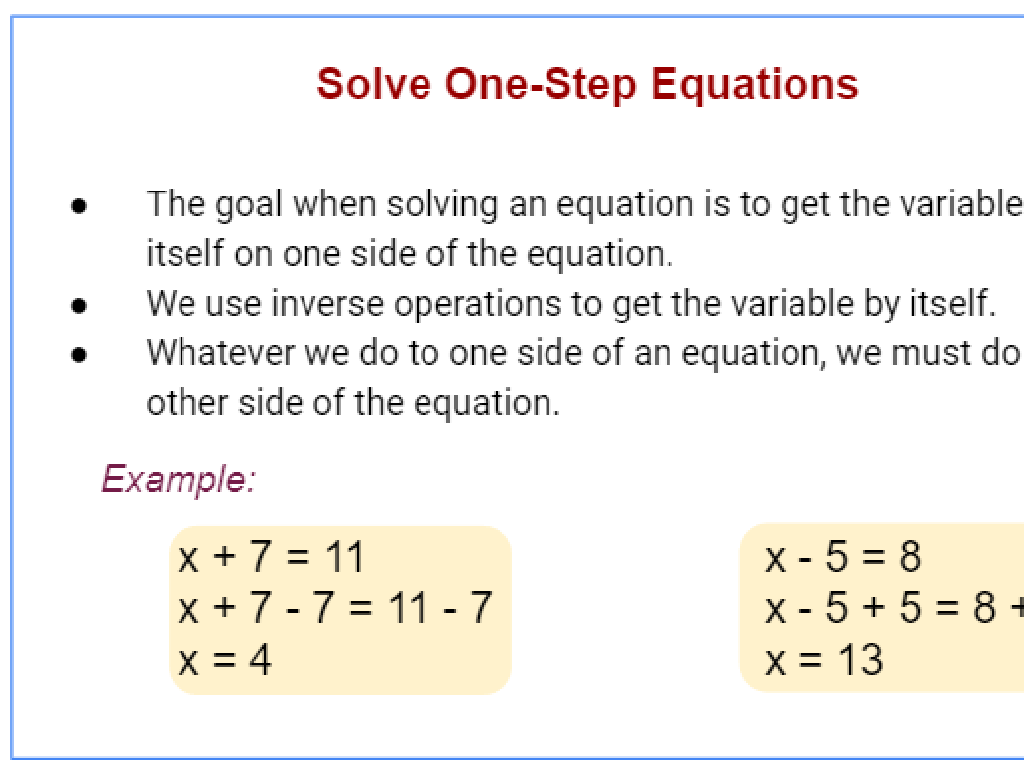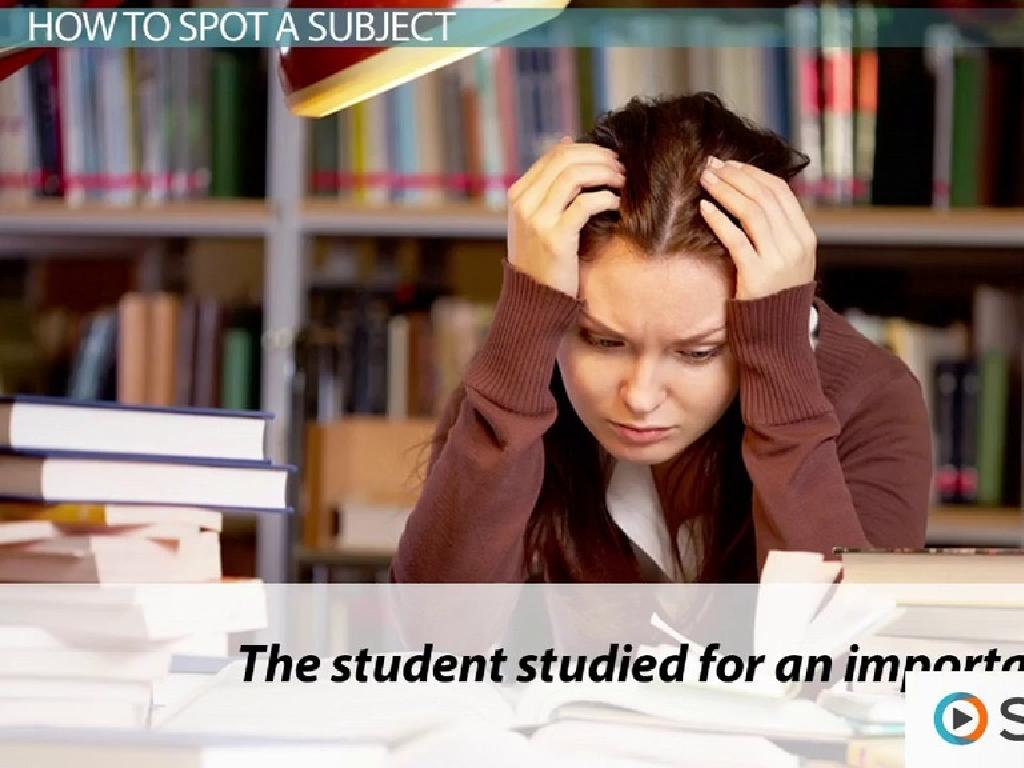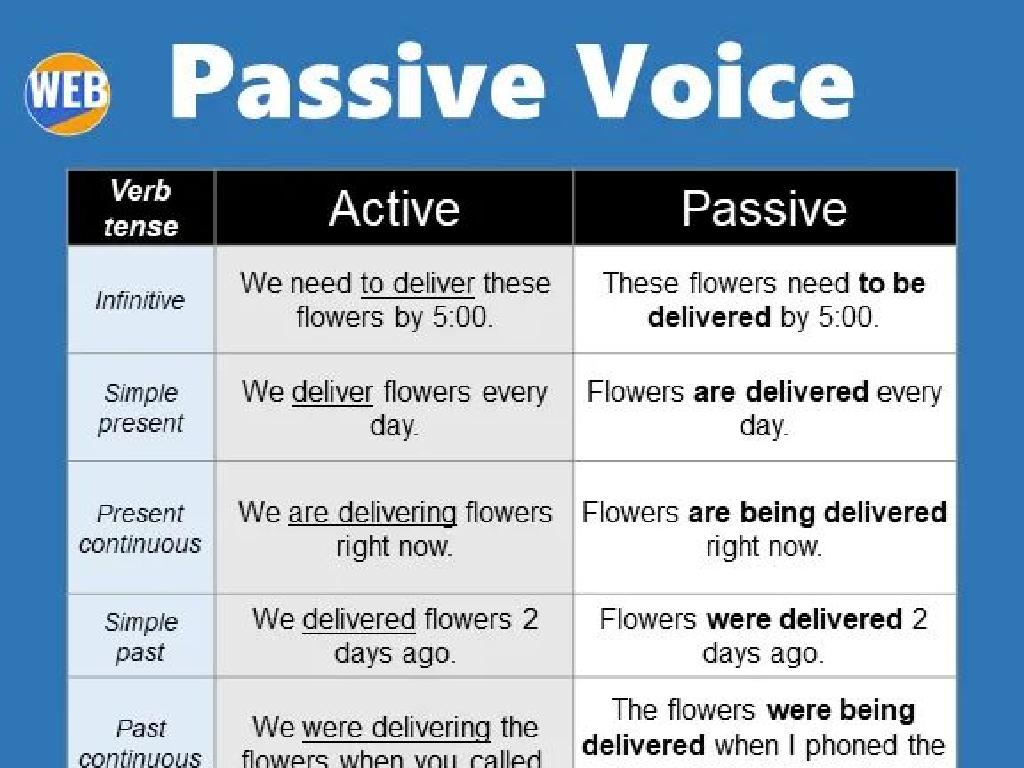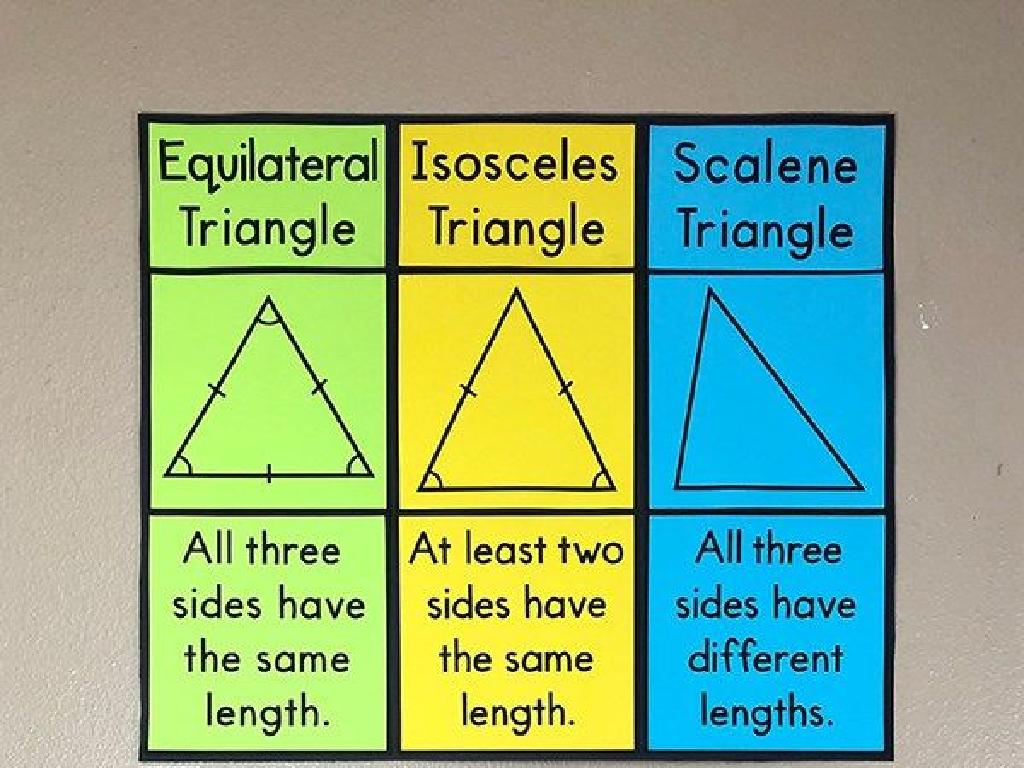Use Sense Words
Subject: Language arts
Grade: Third grade
Topic: Adjectives And Adverbs
Please LOG IN to download the presentation. Access is available to registered users only.
View More Content
Exploring Sense Words
– Welcome to Language Arts!
– Discover ‘Sense Words’
– Words that describe using senses
– Sense words describe our world
– Example: ‘The cinnamon smells spicy’
– They relate to our five senses
– Sight, sound, smell, taste, touch
|
Today’s lesson introduces ‘Sense Words’, which are adjectives and adverbs that describe objects and experiences through our senses. Emphasize that these words make descriptions more vivid and help us share our experiences with others. Provide examples for each of the five senses and encourage students to think of their own examples. Engage the class with sensory exploration activities where they can use sense words to describe various objects or scenarios presented to them.
Exploring Sense Words: Adjectives & Adverbs
– Adjectives describe nouns
– Adverbs describe verbs
– Examples of adjectives
– ‘blue’ sky, ‘loud’ music, ‘sweet’ candy
– Examples of adverbs
– run ‘quickly’, speak ‘softly’, smile ‘happily’
|
This slide is aimed at providing a quick review of adjectives and adverbs for third graders. Adjectives are words that describe nouns, which are people, places, things, or ideas. Adverbs, on the other hand, modify verbs, adjectives, or other adverbs, often telling how, when, where, why, or how much. By providing examples, students can see how these descriptive words function in sentences. ‘Blue’, ‘loud’, and ‘sweet’ are adjectives that give us more information about the nouns they describe. ‘Quickly’, ‘softly’, and ‘happily’ are adverbs that tell us more about the actions. Encourage students to come up with their own examples and use them in sentences to enhance their understanding of adjectives and adverbs.
Exploring the Five Senses with Sense Words
– Our senses help us experience life
– We have five senses: sight, hearing, smell, taste, touch
– Match words to the right sense
– Use clues from words to connect them to a sense
– Examples: ‘bright’ for sight, ‘loud’ for hearing
– ‘Sweet’ for taste, ‘soft’ for touch
|
This slide introduces the concept of the five senses and how they relate to descriptive words, or ‘sense words.’ Begin by explaining how each sense gives us information about the world. Then, list the five senses and provide examples of sense words that correspond to each one. Encourage students to think of additional sense words and which sense they relate to. For the activity, students will match given words to the correct sense. This exercise will help them understand adjectives and adverbs related to sensory experiences and enhance their descriptive writing skills. Prepare a list of words for the matching activity and consider bringing in objects or pictures to aid in this interactive learning experience.
Exploring Sense Words: Sight
– ‘Bright’, ‘colorful’, ‘dark’ describe visuals
– These words help us picture things in our mind
– Think of bright objects
– The sun or a light bulb are good examples
– Write sentences with sight words
– Use ‘bright’ in a sentence about the sun
|
This slide introduces students to adjectives related to the sense of sight. Start by explaining that sense words help us describe what we see in the world around us. Words like ‘bright’, ‘colorful’, and ‘dark’ can paint a picture in our minds of the scene being described. Encourage the students to think of their own examples of bright things, which could include the sun, a light bulb, or even a shiny coin. Then, move on to a class activity where students write sentences using these sight words. This exercise will help them understand how adjectives enhance their writing and make it more vivid. Provide guidance and examples to ensure they grasp the concept.
Exploring Hearing with Sense Words
– ‘Loud’, ‘quiet’, ‘screeching’ describe sounds
– Discuss: What sounds loud to you?
– A firetruck siren or a thunderstorm might sound loud
– Create sentences using hearing words
– ‘The screeching owl was loud in the quiet night’
– Understanding adjectives for hearing
– Adjectives like ‘loud’ help us share how we experience sounds
|
This slide is aimed at helping third graders understand how to use adjectives related to the sense of hearing. Start by explaining that adjectives are words that describe nouns and can tell us more about the sounds we hear. Encourage the students to think of examples of loud and quiet sounds they encounter in their daily lives. Then, guide them to create sentences using words that describe these sounds, reinforcing their understanding of adjectives and adverbs related to hearing. This activity will help them to not only learn new vocabulary but also to appreciate the nuances of sound in their environment.
Describing Smells with Sense Words
– ‘Fragrant’, ‘stinky’, ‘fresh’ are smell words
– These words help us describe how things smell
– How does a rose smell to you?
– Is it fragrant, sweet, or another smell word?
– Write sentences using smell words
– Use your nose and imagination to write
|
This slide introduces students to adjectives that describe smells, which are important for creating vivid imagery in writing. Start by explaining that sense words related to smell can bring writing to life and help readers imagine the scene. Encourage students to think of different smells they encounter in their daily lives and the words that best describe them. Provide examples of sentences using smell words to guide them. For the activity, have students write their own sentences using the new vocabulary. They can describe their favorite scents or things they encounter every day. This exercise will enhance their descriptive writing skills and make them more aware of the use of adjectives in language.
Exploring Taste with Sense Words
– ‘Salty’, ‘bitter’, ‘sweet’ describe tastes
– Examples of ‘sweet’ taste
– Sugar and honey are things that taste sweet.
– Create sentences using taste words
– ‘The salty popcorn was delicious.’
– Understanding taste adjectives
– Adjectives like ‘sour’ or ‘spicy’ tell us about the flavor of food.
|
This slide is aimed at helping third-grade students understand and use adjectives related to taste. Start by explaining that sense words help us describe our experiences, particularly how things taste. Provide examples of common taste words such as ‘salty’, ‘bitter’, and ‘sweet’. Use relatable examples like sugar for ‘sweet’ and ask students what else might taste sweet to them. Encourage them to make sentences with these words, reinforcing the concept that these adjectives give us more information about the nouns they describe. Discuss how these words can add detail and interest to their writing. For the activity, have students think of their favorite foods and describe them using taste words in creative sentences.
Exploring Touch: Sense Words
– ‘Soft’, ‘rough’, ‘slippery’ describe touch
– These words help us describe how objects feel to the touch.
– How does petting a kitten feel?
– A kitten’s fur is often soft and fluffy.
– Write sentences with touch words
– Use touch words to write about different textures.
|
This slide introduces students to adjectives related to the sense of touch. Begin by explaining that sense words help us describe our experiences more vividly, especially how things feel. Use tactile examples like ‘soft’, ‘rough’, and ‘slippery’ to illustrate the concept. Ask the students to think about how it feels to pet a kitten to connect the idea to a soft texture. Then, encourage them to write sentences using touch-related words, focusing on creating clear images in the reader’s mind. For the activity, provide various objects with different textures for the students to touch and describe. This will help them understand and apply the use of descriptive words in their writing.
Bringing Stories to Life with Sense Words
– Authors use sense words for vivid stories
– Imagine being inside a story setting
– What do you see, hear, smell, touch, taste?
– Describe the setting with sense words
– Use words like ‘sparkling’, ‘thundering’
– Write a paragraph using sense words
– Share your story in the next class!
|
This slide aims to teach students how to use adjectives and adverbs related to the five senses to enhance their writing. By using sense words, authors can create a vivid picture in the reader’s mind, making the story more engaging and relatable. Encourage students to think about their senses and describe a setting as if they were really there. For the activity, guide them to write a short paragraph about any place they like, using sense words to describe it. This exercise will help them understand the importance of sensory details in storytelling. In the next class, students can share their paragraphs and discuss the different sense words they used.
Class Activity: Sensory Scavenger Hunt
– Explore with a sensory scavenger hunt
– Match objects to sense words
– Find items that are ‘smooth’, ‘loud’, or ‘bright’
– Pair up and use your senses
– Record findings on your hunt sheet
– Use the sheet to note down the objects and their corresponding sense words
|
This activity is designed to engage students in a hands-on learning experience about adjectives and adverbs related to the five senses. Teachers should prepare a scavenger hunt sheet with columns for each of the senses (sight, sound, smell, taste, touch) and space for students to write down their findings. Encourage students to explore the classroom in pairs, looking for items that can be described using sense words. For example, they might find a bell for ‘loud’, a silk scarf for ‘smooth’, or a bright lamp for ‘bright’. After the hunt, facilitate a discussion where pairs can share their discoveries and describe the objects using their chosen sense words. This will reinforce their understanding of descriptive language and how it relates to sensory experiences.

